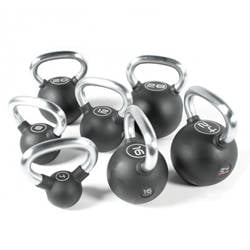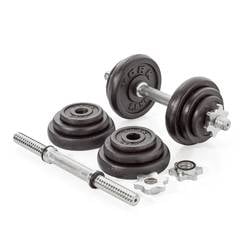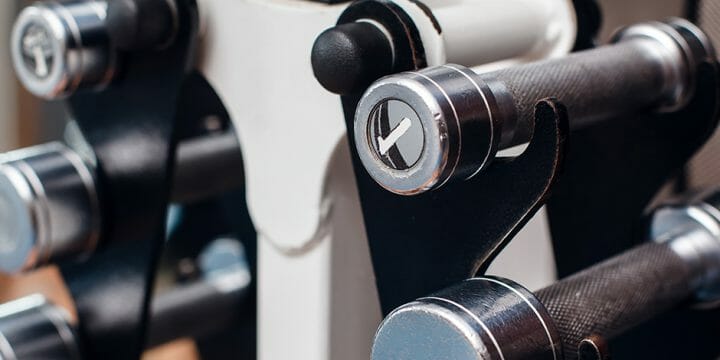Kettlebells vs. dumbbells are intended for completely different uses, and you shouldn’t be trying to argue that one is better than the other.
What I hear a lot is that people buy the wrong type of equipment for the types of fitness and strength exercises they intend to do.
So, I'll use my years of experience as a fitness trainer to explain some basics, so you don't make the same mistake when choosing between them.
Quick Summary
- Choosing between kettlebells and dumbbells depends on your fitness goals: kettlebells are better for compound exercises, while dumbbells excel in targeted strength training.
- Kettlebells, with their unbalanced design, are ideal for full-body movements, engaging multiple muscle groups effectively.
- A study in Research in Sports Medicine highlights that kettlebells are more likely to be used for compound exercises targeting multiple muscles.
- Personally, I find kettlebells more challenging and rewarding for full-body workouts, offering a dynamic range of exercises.
What Are Kettlebells?

Kettlebells are a type of free weights that resemble a cannonball with a flat bottom and a D-shaped handle.
You’ll find them in a wide range of weights from as little as two pounds to over 100 pounds.
Our gym has some 100-pound kettlebells, and it’s impressive to see what people do with them.
In most cases, they are made from steel or concrete, which is then covered in plastic or rubber. This covering is designed to avoid damage to floors and also to make them less harsh on your hands during strength training.
Related Article: Best Kettlebell Back Exercises
What Are Dumbbells?

I know people sometimes get confused with dumbbells and barbells, so this section hopefully clears the difference out.
Dumbbells are a very common type of free weights that usually come in pairs of the same weight. The design is generally a short handle with equal bulging weight at each end.
When using dumbbells, I've noticed their balance is perfect for isolating specific muscles, enhancing both stability and range.
In some cases, they are made as a standalone unit, but you can also get some that you can change the weight at each end of the bar.
You’ll see these on racks at your gym, and full sets can be quite expensive as you would want to have the same weight for each hand.
However, there are some adjustable dumbbell options available as well, which might be more practical for use at home.
Here are some of our favorites:
Or read our comparison articles:

How Does The Physical Shape Influence Exercise?
As you look at a kettlebell next to a dumbbell, you’ll notice that they are very different indeed. Their shape will influence how you hold them in your hand and what kind of movements you can do with them.
Kettlebells are generally more suitable for full-body movements designed as strength exercises. According to a study published in Research in Sports Medicine, you’re more likely to hit compound exercises [1] that target multiple muscles at the same time.
Many of my clients find dumbbells easier to grip, and you could use two of them unilaterally for power lifting, squat movements, curls, and even for a bench press.
Let’s take a closer look at individual advantages.
Advantages of Kettlebells

Here are the main advantages of using kettlebells for your exercises:
1 - Smooth Grips
A kettlebell pretty much always has a smooth surface that may be less severe when you hold them tight. A lot of dumbbells are metal and even have a rough surface.
2 - Multi-Hand Grip
There are many kettlebell exercises that might require you to get both hands on the grip and start a swinging motion from a squat position. This would be quite difficult with dumbbells.
3 - Unbalanced Design
Kettlebells are not balanced like dumbbells are and therefore require you to use them very differently.
In my workouts, kettlebells' unbalanced design has been key for engaging multiple muscle groups simultaneously, especially in full-body movements.
Read More: Best Adjustable Kettlebells
Advantages of Dumbbells
Now, let’s take a closer look at dumbbells:
1 - Increased Stability
What most people like about them is the way they balance in your hand. You can grab them in the middle, and the weight is evenly distributed. Because of the bell shape of kettlebells, that’s not possible.
2 - Better Safety
The balance mentioned above comes with another bonus for strength training and that safety. Basically, the more you bench press, the more in control you have to be over the way your arms move.
Also, with certain types of squat exercises, you could do damage to your back if you’re constantly off-balance during the workout [2].
3 - Target Specific Muscles
As a trainer, I've seen bodybuilders prefer dumbbells for their ability to precisely target specific muscles.
Once your body has bulked up enough, you might like that kind of control as well.
4 - More Range Of Motion
Like the previous advantage, the balance of a dumbbell might give your body a lot more range of motion than a kettlebell. This might be helpful in a workout when you’re aiming for maximum power and strength.
Read More:
One of the reasons why people choose dumbbells over weight machines is because of the free range of motion that they allow the lifter.
- AmericanFitness.net
Detailed Comparison of Weight Increments and Progression
When it comes to strength training, the progression of weight is a critical factor. Kettlebells and dumbbells differ significantly in this aspect, influencing how individuals can advance in their training.
Kettlebells: Larger Leaps in Weight
Kettlebells traditionally follow the Russian measurement unit known as the 'pood,' which is approximately 16 kilograms or 35 pounds.
This historical basis leads to kettlebells having larger weight increments, typically ranging between 4 to 8 kilograms (9 to 18 pounds).
This was particularly evident when I transitioned from a 16 kg kettlebell to a 24 kg one, challenging my strength and endurance in a way that smaller increments wouldn't.
Such jumps can be substantial, especially for beginners or those looking to make gradual increases in their lifting capacity.
Dumbbells: Finer Weight Gradation
In contrast, dumbbells offer more refined weight increments, usually stepping up in 2.5 or 5-pound intervals. This finer gradation allows for a more controlled and gradual progression in strength training.
From my personal routine, I've appreciated how dumbbells provide finer weight increments.
This allowed me to gradually increase the weight in my bicep curls and shoulder presses, ensuring a steady progression without overwhelming my muscles.
Implications for Training
The difference in weight increments means that kettlebells might be more suited for those who are already at an intermediate or advanced level of strength training, where larger weight jumps are manageable.
On the other hand, dumbbells are ideal for beginners or for exercises that require more nuanced weight progression.
About The Author
You May Also Like





